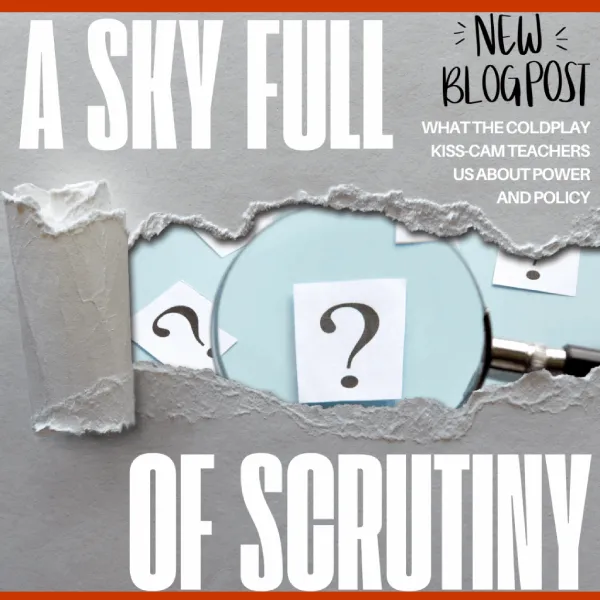We’ve all seen the memes (if you haven’t, where have you been?!): that kiss-cam clip from a Coldplay concert that did laps around the internet, racking up numbers the band probably hasn’t seen outside a tour ledger. At the centre of it, two faces that were previously relatively unknown to the wider world: a tech Chief Executive Officer and the company’s Chief People Officer. The camera lingers, the crowd reacts, and by morning the internet has their names, job titles and endless opinions.
Now, we’re not a tabloid and have no interest in gossip, but this story does make for a fascinating and clear case study on the governance. With our HR lens on, we applied it to the issue at hand to look at what actually breaks down inside a company the moment a personal relationship exists between executive power and the person responsible for writing and enforcing the rules.
Power, proximity, and why this one hit differently
Personal relationships within the workplace aren’t unusual, and for the most part, they can be managed without much fuss. But the reason this one lands differently because of the roles involved. A CEO can shape pay and promotions with a single sentence. A CPO writes the rules that are meant to keep that power square and runs the process when things go sideways. Put those two roles too close together and the whole system tilts- even good decisions suddenly need daylight to be believed.
It’s important to remember that people don’t need proof of wrongdoing to change their behaviour; they only need to doubt the umpire. Once that doubt takes hold, speak-up rates fall, back-channels grow, and your “culture” becomes whatever people feel safe saying in private. Culture doesn’t implode overnight either – as we’ve seen from our years of experience – it frays slowly, thinning at the edges until it finally tears.
And that’s what is at the heart of it: not “is this right or wrong,” but “can employees still trust the machinery?” HR’s authority is borrowed from that trust. The moment HR becomes part of the story, the rent comes due.
When process follows the headline
Old playbooks assume a neat order: a concern is raised, intake follows, an investigation runs, findings are made, leaders communicate. The internet doesn’t honour that order. As seen in this case, visibility came first, questions second, and processes scrambled to catch up. Its uncomfortable, but it’s the world that all our current workplace leaders operate in. More often than not, you don’t always get to decide whether something is public; you only get to decide whether your handling still looks credible once it already is.
The morality angle
It’s tempting to declare “not a morality tale” and move on, but that misses something we think is fundamentally important to consider. In our current age, organisations trade in values as much as they trade in products.
When a visible leader’s private choices clash with the values on the wall (integrity, respect, fairness) people don’t reach for the policy first; they check for double standards. The quiet question is, do the rules hold for them the way they hold for me? That’s a moral instinct wearing a governance badge. And to answer it – you don’t have to publish every detail to prove the rules matter, you just have to make it clear they were applied fairly. Big statements aren’t the same as fairness and if leaders appear to get a softer deal, trust erodes.
And it’s important to note that these sorts of stories are becoming more common because boundaries have shifted. Phones flatten distance, and hybrid work blurs time and place. Offsites and industry events now live in a grey zone where work and not-quite-work bleed together- and someone is always filming. Side gigs, DMs, politics, public posts: leaders are brands now, and brands are permeable. As such, more often we find that personal choices cast professional shadows and veen when no line is technically crossed, perception runs ahead of the facts. That’s why reputational risk needs a true home in how we think about conduct, not as an afterthought, but as part of the design.
What the clip reveals about the culture underneath
A moment like this is a kind of culture X-ray. It shows whether people believe the complaints pathway is safe, whether managers think policy applies to the top of the house, whether the board gets more than a dashboard, and whether values are lived or just laminated. It also tests whether HR’s authority is structural or personal. When HR itself is in the frame, can independence be demonstrated rather than promised? Can the function step back gracefully and let an unconflicted path carry the weight?
Questions worth taking back to your team
Now, we’re advocating for this as case-study material, not a witch hunt. And ask yourself: if a frontline employee saw that clip and knew who was involved, what would they assume about fairness tomorrow? Would they still trust the complaints system? If the same story unfolded here, who would step out of decision-making and who would step in? How would you balance privacy with the need to show the rules apply? What would your board want to know on day one, and could you put it on one page without euphemism? And the uncomfortable one: which parts of your current set-up depend on trusting particular people, and which parts rely on design that works no matter who’s in the photo?
A case study, not a checklist
There are obviously moves any competent organisation would make, but that’s not the point of this piece. The point is to see how quickly personal choices by visible leaders become organisational questions, and how much resilience depends on things you can’t retrofit in a hurry: credibility, independence, a complaints pathway people will actually use, a board that treats culture as a core risk, and a values conversation that isn’t only for inductions and town halls.
If nothing else, treat the Coldplay saga as a tabletop exercise to run while the room is calm. Walk through the governance angles, acknowledge the moral ones. Sit with the tension between privacy and transparency, freedom and accountability, trust in people and trust in design.
Some considerations for your workplace:
When talking about policies, you don’t need a novella; you need something a new manager can follow easily:
- Define plainly what a “close personal relationship” is.
- Ask for disclosure within days, not “as soon as practicable.”
- Acknowledge that perception matters even when there’s no direct authority, and explain what happens in that grey zone.
- Most importantly: pre-wire the independence path. If a matter involves HR or the executive team, control should automatically shift to an unconflicted channel, such as the company secretary, external counsel, or the board committee. You shouldn’t be negotiating independence in the middle of the mess.
Boards aren’t spectators
It’s important to remember that culture is a governance job, not a favour delivered by the HR department. As such, Chairs (of Boards) should expect a same-day heads-up when a conflict like this appears, and be ready to back an independent process even if it’s messy or politically awkward. If the People & Culture committee meets at the speed of diaries rather than risk, then we say that’s a signal to change the cadence.
HR is human; the system has to be sturdier than any one person
We’re all human, and we all make mistakes, so the professional bar here isn’t sainthood. It’s the ability to recognise a conflict, step back without defensiveness, and trust the structure you’ve built to carry the weight. A function that can judge itself cleanly is a function people will rely on for the next hard thing.
The takeaway
Don’t dismiss this story as a weird American footnote. Treat it as a live-fire drill that happened in public and an opportunity to revisit drawing the line between personal freedom and professional accountability. We’d bet that if your settings can withstand scrutiny on a ten-metre screen, chances are they’ll hold up when the real questions come.




Comments are closed.